How to "Read" a Beach
How to Read a North Carolina Beach
UNC Press
What determines the size of sand and cobbles on a beach?
What is a beach?
A beach is the land along the edge of a body of water and is usually made up of any number of materials – sand, gravel, pebbles, cobbles, rock, or shells. Beach material accumulates on the beach during periods of accretion or moves away from the beach during periods of erosion. Never stationary for long, beaches are always moving. Beaches can be hundreds of kilometers long or very short. The coast is a more general term referring to the junction of land and water, but a beach is made of specific materials like sand, cobbles, or shells.
What is sand made of?
On many beaches, most of the sand (not including seashells) is made of the minerals quartz and feldspar. These grains ultimately came from igneous and metamorphic rocks that typically are very old. Quartz, the most common mineral, is composed of silicon dioxide, while feldspar, the second most common mineral, is made up of sodium, calcium, or potassium combined with silica. Quartz is the most common mineral in many beaches because it is very hard and durable, and survives both transport by rivers to the coast and reworking by waves better than any other common mineral. In addition, quartz is chemically very stable.Other minerals disappear rapidly due to chemical and mechanical destruction before they reach the beach. Another durable mineral is the mica, muscovite. Although not as abundant as quartz and feldspar, mica flakes are very visible in beach sand, even when they form less than one percent of the grains. The flat flakes will lie on the surface of the beach, and on a sunny day when the grains catch the light angle off the beach, a sparkle is produced, especially in the wave swash zone. Mica is the sparkle in the beach. However because mica grains are light and flat, they are easily suspended by waves, and are usually removed from the beach by waves to be deposited in deep water beyond the edge of the continental shelf. Quartz and feldspar are light colored and translucent, and if they are not iron-stained, the beach will be gray in color. But on some beaches, the sand grains are iron-stained (oxidized like rust), departing a light yellow to yellow-brown color to the beach. A large part of the brown coloration of our beaches also comes from brown-stained shells that have broken down into small sand-sized fragments in the surf zone and have become mixed with the quartz sand grains.
 These dark sand are from Tanalot Bali in Indonesia near black volcanic rock. This photo was taken less than 25 kilometers away from the photo below.
These dark sand are from Tanalot Bali in Indonesia near black volcanic rock. This photo was taken less than 25 kilometers away from the photo below.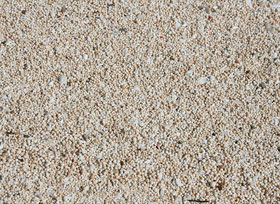 This lighter and larger sand comes from near Bali in Indonesia. The source of this sand is not volcanic, but the eroding massive coral reef in front of it.
This lighter and larger sand comes from near Bali in Indonesia. The source of this sand is not volcanic, but the eroding massive coral reef in front of it.Beach Color
Beaches come in many colors: white, black, tan, yellow, red, and more. Basically, beach material is small pieces of rocks that have eroded and have been carried to the beach via the wind and water. The geology of the surrounding area determines the color of those rocks. This determines what material is available for a beach. In Hawaii, much of the rock there is black basalt making the sand black on some beaches. In other areas, coral or white quart may provide the sediment supply for white beaches. Most beaches are some shade of brown or tan, but when the source is uniform, the colors can be extreme. Look closely at beach sand and you will probably see many different colors, each one representing a different parent rock or source rock.
What determines the size of sand or cobbles on a beach?
Two things determine the size of sand on beaches: the energy (height) of the waves, and the size of the material furnished to the beach. Other things being equal, the higher the average waves on a beach, the coarser the sand. This is because higher waves tend to move the smaller grains offshore to quieter water. Dune sand is consistently finer grained than the adjacent beaches even though the dune sand is derived from winds blowing across the beach. The difference in size is due to the fact that winds generally only pick up and carry the finer grains of beach sand and leave the heavier, larger sand grains behind.
Grain size determines the slope of the beach. Beaches with finer grain sizes tend to be flatter with gentler slopes (between the high and low tide line) than beaches with coarser grains. The reason for this has to do with the ability of sand to absorb water (porosity and permeability) from wave swash. Fine sand absorbs relatively little water and most of the water that flows up the beach also flows back down the beach. This backwash tends to move sand in a seaward direction and thus flattens the beach. Coarse sand or gravel on a beach absorbs much more of the wave swash and more water moves up the beach when a wave breaks than moves back down toward the sea. Less backwash means fewer sand grains moving back. In other words in a coarse sand beach the tendency is to move sand landward and pile it up in a relatively steep slope. Silt and clay are the grain sizes that make mud when they’re wet and dust when they’re dry. Minerals of this size, where individual grains cannot be identified by the naked eye, are generally the weathering products of rocks found far inland away from the beaches. Mud is rarely seen on beaches because the waves suspend such fine-grained material and quickly move it either seaward into deeper water or landward into the sounds and marshes behind barrier islands. Sometimes layers of mud appear on beaches after storms. These layers of mud usually contain fragments of vegetation indicating that they are of salt marsh origin. They got to the beach as the island migrated over them. These lumps are derived from beach nourishment projects that used material with too much mud in it.
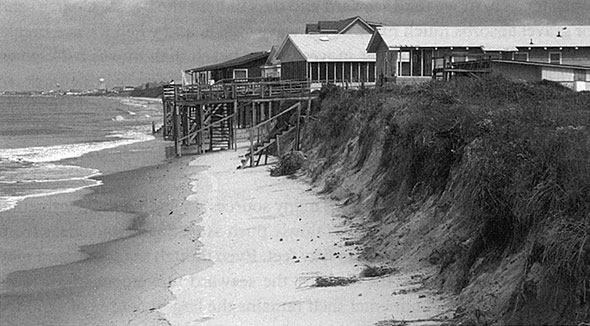 A July 1999 photo of an erosion scarp on the frontal dune at Caswell Beach. In a natural system, this erosion would supply sand to the beach as part of the natural storm response. But when the houses are in the way, the natural beach equilibrium creates serious problems for beach communities. In the background, on the nearest cottage deck that is now exposed to the beach, someone is fishing in the surf zone.
A July 1999 photo of an erosion scarp on the frontal dune at Caswell Beach. In a natural system, this erosion would supply sand to the beach as part of the natural storm response. But when the houses are in the way, the natural beach equilibrium creates serious problems for beach communities. In the background, on the nearest cottage deck that is now exposed to the beach, someone is fishing in the surf zone. Beach Nourishment at Ocean Isle, March 2001. Almost the entire ebb tidal delta of Shallote Inlet was removed to provide this sand, show spewing from a pipe onto the beach. Since the ebb tide delta is part of the barrier island, one could characterize this operation as robbing Peter to pay Paul, or mining the island to save the island.
Beach Nourishment at Ocean Isle, March 2001. Almost the entire ebb tidal delta of Shallote Inlet was removed to provide this sand, show spewing from a pipe onto the beach. Since the ebb tide delta is part of the barrier island, one could characterize this operation as robbing Peter to pay Paul, or mining the island to save the island.
Sources of beach sand
There are many sources of sand on beaches including the continental shelf. During fair weather, waves slowly push ashore sand and shells from water depths as great as 30 to 50 feet. Even though the same sand may be partially lost back to the shelf in a seaward direction during storms, the continental shelf remains the largest source of sand for many beaches. Longshore transport is just one of several sources of beach sand, bringing sand from updrift beaches, sand bars, or tidal deltas. If there are bluffs or cliffs backing the beach, waves will inevitably erode them and provide sediment to the beach. Low bluffs or cutbanks can form the shores of some estuaries and also provide sand to their narrow beaches. Dunes along barrier islands supply a lot of sand to the beaches. This occurs when strong winds blow sand in an offshore direction or when storms erode and cut back the dunes. Rivers can also furnish sediment to beaches and are the major source of beach material in California. Dams on rivers have a huge impact on California beaches and lead to increased erosion. The shells on a beach also supply sediment as they are broken up by the waves or by scavenging organisms such as skates or rays (or beach buggies). An increasingly important sand source on an ever increasing number of beaches is nourishment sand, dumped there by humans. Many communities now nourish their beaches bringing in sand from inland sand pits, or dredging and pumping sand from local inlets or from offshore on the continental shelf.
Beach Variables
Beaches come in a variety of sizes, shapes, and compositions. Some are wide, some narrow, some steep and others gentle, some with considerable shell content, and some with no shells. If you revisit a beach over a period of time you will find that the beach width changes and that the slope steepens or flattens in response to some seemingly invisible force of nature. If you know the right places to go, you may find tree stumps exposed in place on the beach, outcrops of mud layers, or rocks on the beach. And while the bulk of the beach is quartz, sand and shell, examination of a particular beach may lead to the discovery of a Mastadon tooth or bone fragment, sharks’ teeth, Giant fossil oyster shells, chunks of fossiliferous limestone, or smooth, flat quartz pebbles. These fascinating beach forms, fragments, and fossils are clues to the history of the beaches and how they formed.
Types of beaches
There are four main types of beaches. Barrier island beaches are beaches that start and end in the water and cover vast portions of our world’s coasts. These shifting shoals of sand are generally migrating towards the mainland around the world, possibly due to sea level rise. Mainland beaches are simply where the land meets the sea and also comprise many of the world’s beaches. Spits are similar to both types of beaches in that they are connected to the mainland at one end, but end in the water at the other end. When a large storm comes and cuts a new inlet in the spit, a new barrier island is formed. A pocket beach is a unique type of beach that is associated with exposed bedrock nestled between rocky coastal outcrops. They are found around the world and in abundance throughout the northern coast of the eastern United States and Canada.
Beach parts
The recreational beach that we all know and love is the strip of sand extending from the low-tide line to the base of the first dune (Fig. 2.1). The submerged beach or shoreface extends seaward from the low-tide line to a depth of 30 to 60 feet, where the true continental shelf begins. The shoreface is steep and a distinct flattening of the sea floor marks its boundary with the continental shelf. The beach itself, both the emergent and submerged sections, is not featureless. Sandbars and wavy features of huge variety, called bedforms, cover the surface of the beach and shoreface. Not only are there an infinite variety of bedforms on beach surfaces, they are ever changing – each tidal cycle reveals a whole new set of features. Human-made and therefore artificial subdivisions of the beach for descriptive purposes are shown in Figure 2.1.
 Cross-section of a typical barrier island. (Adapted from work by Paul Godfrey; drawing by Charles Pilkey)
Cross-section of a typical barrier island. (Adapted from work by Paul Godfrey; drawing by Charles Pilkey)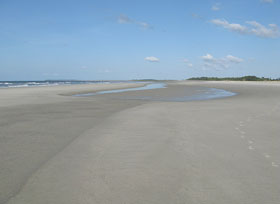 A wide beach berm with a berm crest is to the right, a water-filled trough (runnel), and a new berm to the left. The new berm is a depositional addition to the beach, representing recent accumulation of sand pushed ashore by wave action. This beach on Little Tybee Island, Georgia (USA) is very wide due to the large tidal amplitudes.
A wide beach berm with a berm crest is to the right, a water-filled trough (runnel), and a new berm to the left. The new berm is a depositional addition to the beach, representing recent accumulation of sand pushed ashore by wave action. This beach on Little Tybee Island, Georgia (USA) is very wide due to the large tidal amplitudes.Berms
A common feature on the exposed beach is a berm, a long narrow wedge of sand with its steep slope facing the sea. The long, gentle slope behind this steep face actually slopes toward the land. Some beaches have two and even three berms that resemble terraces.
Berms form during quiet weather, as sand moves in from offshore. Thus a berm is a depositional feature, one that indicates that the beach has been gaining sand in recent weeks or months. Often the sand that makes up a berm was once an offshore bar formed in a storm which then gradually, in a matter of weeks or a couple of months, migrated onto the beach. The observant beach stroller can actually see this movement of sand on repetitive visits as the bars move closer and closer to the beach. Berms often appear on beaches after strong storms. Once a berm arrives onshore it may continue to move up the beach even to a point above the normal high tide line. It is pushed there by either minor storms or spring tides. Meanwhile a new berm may form on the lower beach.
A wide beach berm with a berm crest is to the right, a water-filled trough (runnel), and a new berm to the left. The new berm is a depositional addition to the beach, representing recent accumulation of sand pushed ashore by wave action. This beach on Little Tybee Island, Georgia (USA) is very wide due to the large tidal amplitudes.
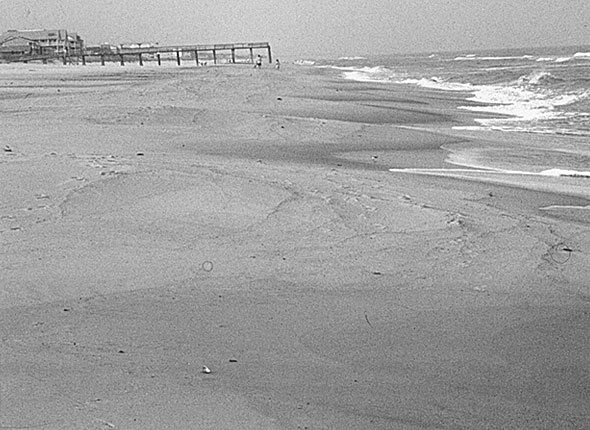 A low-tide beach at Sunset Beach showing a well developed berm, also called a “ridge and runnel.” This berm is being “welded” to the beach as waves slowly work it ashore. In all likelihood, it will be removed by the next storm.
A low-tide beach at Sunset Beach showing a well developed berm, also called a “ridge and runnel.” This berm is being “welded” to the beach as waves slowly work it ashore. In all likelihood, it will be removed by the next storm.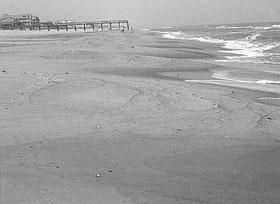 Beach cusps on Carolina Beach following Hurricane Bonnie in 1998. These common features are evenly spaced “horns” separated by embayments near the high-tide level of the beach.
Beach cusps on Carolina Beach following Hurricane Bonnie in 1998. These common features are evenly spaced “horns” separated by embayments near the high-tide level of the beach.Beach Cusps
Beach cusps can sometimes be carved on the outer rim of the berm of a beach. These horn-like and amazingly evenly-spaced features consist of protruding sections of the beach that alternate with small embayments. Beach cusps give the beach a wavy or undulating appearance. If you have ever walked along the water’s edge only to find yourself going up and down a gently rolling surface, you’ve probably been walking across a series of beach cusps. These cusps are typically uniformly spaced (anywhere from 10 to 50 yards apart) and look like scallops from above. When you are on a beach with beach cusps, you will notice that the wave swash is deflected by the horns into the rounded out embayments. In this way the horns are usually gaining sand (accreting) and the embayments are losing it (eroding). The difference in elevation between the horns and embayments is usually on the order of a couple feet or more. Cusps are most likely to form when wave crests parallel the shore, but they are ephemeral features and change shape and size with changing wave conditions. The sudden appearance and equally sudden disappearance of cusps is just one more mystery of the beach. But if you watch closely and carefully enough you may be able to shed light on this riddle.

